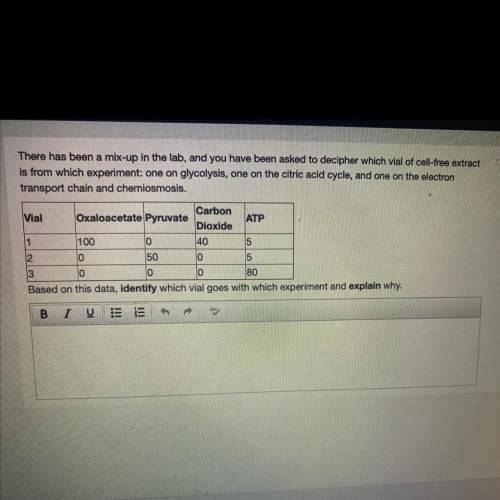
Biology, 05.11.2020 23:00 dayanaraa61
PLEASE HELP!
There has been a mix-up in the lab, and you have been asked to decipher which vial of cell-free extract
is from which experiment: one on glycolysis, one on the citric acid cycle, and one on the electron
transport chain and chemiosmosis.


Answers: 1


Other questions on the subject: Biology

Biology, 22.06.2019 03:00, seahorse0
To answer this question, researchers studied populations of the dusky salamander (desmognathus ochrophaeus) living on different mountain ranges in the southern appalachian mountains. the researchers tested the reproductive isolation of pairs of salamander populations by leaving one male and one female together and later checking the females for the presence of sperm. four mating combinations were tested for each pair of populations (a and b)—two within the same population (female a with male a and female b with male b) and two between populations (female a with male b and female b with male a). the proportion of successful matings for each mating combination was measured. for example, when all the matings of a particular combination were successful, the researchers gave it a value of 1; when none of the matings were successful, they gave it a value of 0. then the researchers calculated an index of reproductive isolation that ranged from 0 (no isolation) to 2 (full isolation). the reproductive isolation value for two populations is the sum of the proportion of successful matings of each type within populations (aa + bb) minus the sum of the proportion of successful matings of each type between populations (ab + ba). the table provides data for the geographic distances and reproductive isolation values for 27 pairs of dusky salamander populations.
Answers: 1

Biology, 22.06.2019 13:00, Brooke7644
In trying to determine whether dna or protein is the genetic material, hershey and chase made use of which of the following facts? a) dna contains sulfur, whereas protein does not. b) dna contains phosphorus, whereas protein does not. c) dna contains nitrogen, whereas protein does not. d) dna contains purines, whereas protein includes pyrimidines.
Answers: 3

Biology, 22.06.2019 23:00, enrique3300
Identifies and describes 3-4 components of the endocrine system (10 points) transfers meaning from one subject (endocrine system) to another (scenario/example) (10 points)
Answers: 1
You know the right answer?
PLEASE HELP!
There has been a mix-up in the lab, and you have been asked to decipher which vial of...
Questions in other subjects:

Biology, 28.07.2019 13:30

Business, 28.07.2019 13:30

Mathematics, 28.07.2019 13:30



Mathematics, 28.07.2019 13:30


Biology, 28.07.2019 13:30

Social Studies, 28.07.2019 13:30



